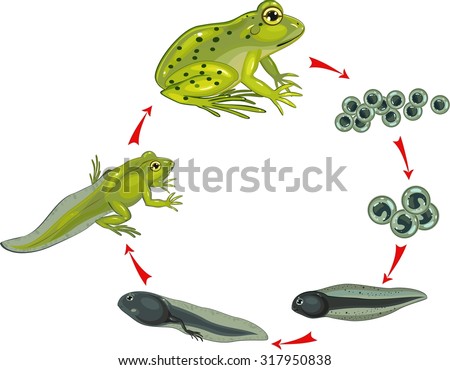The ratio of amphibians to reptiles is about 3/4 which is pretty close actually. These two classes do make up the herpetology department that so many people know and love! However close these two classes may appear, they consist of some diverse and pretty amazing creatures, and they have quite different life styles and characteristics. Since so far I have been talking about reptiles, I guess the only way I could be a proper "herp" is to have a few articles, which will consist of today and tomorrow then later in the week I will discuss defensive traits that is mixed up and connected to the two classes.
Amphibians as I said before usually have two main stages in their life. In fact the word "amphibian" comes from the Greek language meaning "two lifed". Metamorphosis is the reason for the separate stages, and I will get detailed in exactly how that happens in my next article, so I digress. The first stage usually takes place in the water. This is the eggs hatching. The eggs of most amphibians are jelly like little bulbs. Some amphibians, such as most frogs, will lay their eggs in a jelly cluster or in strands among the edge of the water in algae or other plant life. When the eggs hatch the young amphibians will have gills and some type of aid in swimming. Tadpoles for example have a strong tail they wiggle to propel themselves forward. As you can see in the diagram below the tadpole eventually adapts to land where it then becomes a frog over a period of time and then will mature and lay eggs of its own. There are two man parts of a frogs life that is the tadpole phase (larval phase) and the frog phase (adult phase). Many species of frogs and toads grow in this way, although toads we know have lives that are more independent from water then frogs, and their skin structure is different then that of a frog.
Alright so lets move on from toads to salamanders, which get even better. Now I really want you to get this whole metamorphosis and amphibian "double life" idea in your head because that is a major factor in amphibians life and is something I found very amazing about them. As I said before I plan on talking about how the metamorphosis of an amphibian exactly works and why in my next article. So your salamanders are similar to the stages of a frog they have the larval and adult stages, however the salamanders external gills are easily seen. Newts are very similar to salamanders. Newts spend more of their time on dry land then most salamanders do and their bodies are shaped a bit sturdier then that of a salamander (not so much sluggish). So think about it this way, a salamander is to a newt, AS a frog is to a toad.
 |
| http://www.animalspot.net/salamander |
 |
Amphibians like reptiles are cold blooded and when the weather gets cold many of them will hibernate in borrows or underwater. Some frogs, who aren't the best burrowers will actually find a safe crack or crevice and actually let their bodies freeze. They bodies do have a type of chemical reaction however that serves as an anti-freeze so the toad will just thaw out when Spring comes around, for example wood frogs in Alaska would do this.
So frogs hibernate in some pretty amazing ways but before i end this article I wanna talk about a cool salamander. I mean i personally like salamanders much more then frogs, but that's beside the point. So moving to warmer climates such as Japan we see the monsters of all salamanders, the famous Japanese Giant salamander.
So yeah the two lifed is pretty cool if I may say so myself. Visit my blog the rest of the week and see my other post about amphibians! Thanks for reading! Feel free to ask questions or subscribe! Thanks again!
For some extra info or to see where I received some of my information check out these links. Much of my information came from experience and schooling.
Links:
|

No comments:
Post a Comment